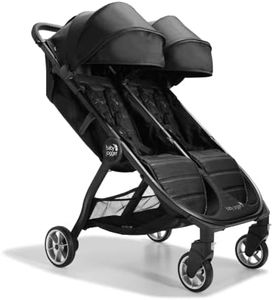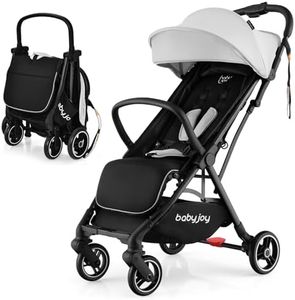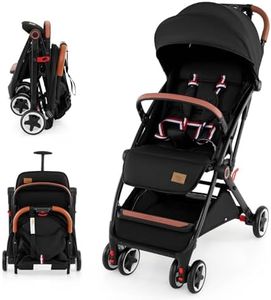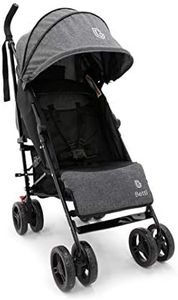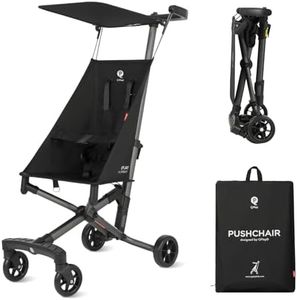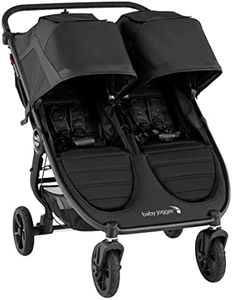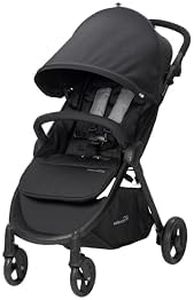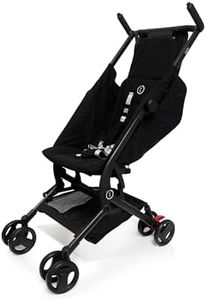We Use CookiesWe use cookies to enhance the security, performance,
functionality and for analytical and promotional activities. By continuing to browse this site you
are agreeing to our privacy policy
10 Best Lightweight Compact Stroller
From leading brands and best sellers available on the web.Buying Guide for the Best Lightweight Compact Stroller
Choosing a lightweight compact stroller can make outings with your child much easier. These strollers are designed to be convenient for travel, quick trips, or city living where space is limited. When picking one, it’s important to think about how and where you’ll use the stroller most, whether it’s for daily errands, travel, or just the occasional walk. Understanding the key features can help you find a model that fits your everyday needs and lifestyle.Weight of the StrollerThe weight refers to how heavy the stroller is when empty. This is important because a lightweight stroller is much easier to carry, lift into cars, and maneuver through public spaces. Lightweight strollers can range from super-light (under 12 pounds) to moderately light (about 15–20 pounds). If you travel a lot or need to carry the stroller up stairs, aim for the lower end. If you only move it short distances, a slightly heavier one with more features might be fine.
Folded SizeFolded size refers to how small and compact the stroller becomes when you fold it up. A compact fold is crucial if you need to fit the stroller into tight car trunks, overhead airplane bins, or small closets. Strollers can fold down to an umbrella shape or into a small rectangular package. Think about your storage space and how often you’ll be carrying or storing the stroller—if you’re tight on storage or travel often, the smaller the fold, the better.
Ease of FoldingEase of folding is about how simply and quickly you can collapse the stroller. Strollers can have one-hand, two-hand, or even automatic folding mechanisms. If you often hold your child while folding up the stroller, a one-hand fold or easy mechanism will be valuable. If you have help or the stroller stays unfolded most of the time, this might be less critical.
Seat Comfort and ReclineSeat comfort involves cushioning and support, while recline means how far back the seat can be adjusted. A more comfortable and reclining seat keeps your child happier on longer outings or allows for naps. Strollers offer fixed, semi-reclined, or fully flat recline options. If your child will spend a lot of time in the stroller, consider better cushioning and a deeper recline. For quick trips, basic comfort may suffice.
Canopy SizeThe canopy is the cover that shields your child from sun or light rain. Canopy sizes range from very small to full-coverage. If you’ll be out in the sun often or want better protection from the elements, look for a stroller with a larger, adjustable canopy. If most trips are short or indoors, a basic canopy is enough.
Storage OptionsStroller storage means the basket or pouches where you can put bags, snacks, or baby supplies. Storage space varies from minimal to generous. If you need to carry shopping, diaper bags, or other items, look for a stroller with a bigger, easy-to-access basket. If you pack light, a small basket is fine.
ManeuverabilityManeuverability describes how easily the stroller turns and glides over different surfaces. Wheel size and design, as well as the handlebar, influence this. Strollers with swiveling front wheels and comfortable grips tend to be the easiest to push. If you’ll use the stroller in busy city streets, shops, or public transport, prioritize easy handling. For occasional use on smooth surfaces, basic maneuverability should work.
Age and Weight LimitThis spec tells you what ages or weights the stroller can safely carry. Some lightweight strollers are only for older babies and toddlers, while others can be used from birth with a flat recline or car seat attachment. Check your child’s age and size, and make sure your pick fits your needs now—and for as long as you’ll need it.
Harness SystemThe harness keeps your child safely strapped in. Harnesses can be three-point or five-point, with five-point being the safest (it secures at shoulders, waist, and between the legs). If your child is very active or young, a five-point system offers more security. For older children who sit calmly during rides, a simpler system may work.
